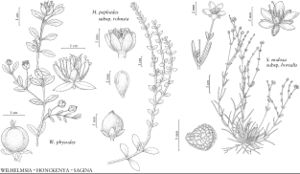Wilhelmsia
Consp. Regn. Veg., 206. 1828.
| Taxon | Illustrator ⠉ | |
|---|---|---|
 | Wilhelmsia physodes Honckenya peploides subsp. robusta Sagina nodosa subsp. borealis | Bee F. Gunn Bee F. Gunn |
Herbs, perennial; rhizomes somewhat fleshy, often with prominent nodal buds. Taproots usually not evident. Stems prostrate to decumbent, flowering-stems erect or ascending, simple or branched, subterete, main-stems often rooting at nodes. Leaves not connate proximally, sessile; blade 1-veined, elliptic-obovate to ovate-rhombic or ovate, slightly succulent, apex weakly acuminate. Inflorescences terminal, solitary flowers; bracts absent. Pedicels erect in fruit. Flowers: perianth and androecium weakly perigynous; hypanthium minute, cupshaped; sepals 5, distinct, green, lanceolate to ovate or elliptic, usually navicular, 2–2.5 mm, herbaceous, margins white to pink or purple, scarious, apex obtuse to acute or short-acuminate, not hooded; petals 5, white, not or narrowly clawed, blade apex entire to weakly emarginate; nectaries as mounds around filaments opposite sepals, swollen on adaxial side; stamens 10, arising from narrow disc; filaments distinct; staminodes absent; ovary 3-locular when young (incompletely 3-celled by inward extension of margins of carpels in fruit); styles 3, narrowly clavate, 2.5–3 mm, glabrous proximally; stigmas 3, subterminal, minutely papillate (30×). Capsules subglobose, inflated, 6-lobed, eventually opening along false septa, sometimes irregularly, into 3, 2-toothed parts; carpophore absent. Seeds 8–16, dark red or brown, subpyriform, laterally compressed, smooth, marginal wing absent, appendage absent. x = 15.
Distribution
nw North America, ne Asia
Discussion
Species 1.
Wilhelmsia always has been treated as an isolated monospecific genus because of its inflated, partially septate ovary, except by American authors who have included it in Arenaria. The resemblance in habit between Honckenya and Wilhelmsia, previously presumed to represent convergence, has proven to reflect a close relationship based on recent molecular studies (M. Nepokroeff et al., unpubl.).
Selected References
None.